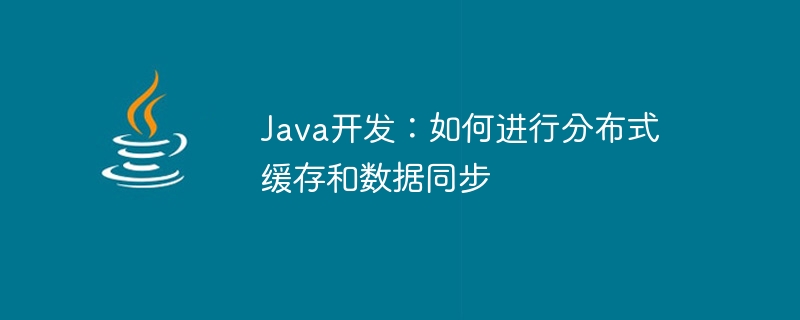Java开发:如何进行分布式缓存和数据同步

Java开发:如何进行分布式缓存和数据同步,需要具体代码示例
引言:
在现代Web应用程序中,分布式缓存和数据同步是常见的需求。分布式缓存可以提高应用程序的性能和扩展性,而数据同步则确保在多个应用程序实例之间保持数据的一致性。本文将介绍如何使用Java开发实现分布式缓存和数据同步,并提供具体的代码示例。
一、分布式缓存的实现
1.1 选择适当的缓存解决方案:
目前,有许多成熟的分布式缓存解决方案可供选择,比如Redis、Memcached等。在选择缓存解决方案时,需要考虑以下几个因素:
- 伸缩性:能否方便地进行水平扩展;
- 可靠性:能否提供高可用性和数据持久化的备份方案;
- 性能:能否提供低延迟的读写操作;
- 功能:是否提供丰富的数据结构和特性,如发布/订阅、事务支持等。
1.2 配置和使用缓存:
以Redis作为分布式缓存解决方案为例,以下是配置和使用Redis的示例代码:
// 引入Redis客户端库
import redis.clients.jedis.Jedis;
public class RedisCache {
private Jedis jedis;
public RedisCache(String host, int port) {
jedis = new Jedis(host, port);
}
public void set(String key, String value) {
jedis.set(key, value);
}
public String get(String key) {
return jedis.get(key);
}
public void delete(String key) {
jedis.del(key);
}
}
// 使用示例
RedisCache cache = new RedisCache("localhost", 6379);
cache.set("key", "value");
String value = cache.get("key");
cache.delete("key");二、数据同步的实现
2.1 使用发布/订阅模式:
发布/订阅模式是实现数据同步的一种常见模式。该模式下,发布者发布消息到指定的频道,订阅者则订阅感兴趣的频道,从而实现数据的自动同步。
以下是使用Redis的发布/订阅模式实现数据同步的示例代码:
// 发布者
import redis.clients.jedis.Jedis;
public class Publisher {
private Jedis jedis;
public Publisher(String host, int port) {
jedis = new Jedis(host, port);
}
public void publish(String channel, String message) {
jedis.publish(channel, message);
}
}
// 订阅者
import redis.clients.jedis.Jedis;
import redis.clients.jedis.JedisPubSub;
public class Subscriber extends JedisPubSub {
private Jedis jedis;
public Subscriber(String host, int port) {
jedis = new Jedis(host, port);
}
public void subscribe(String channel) {
jedis.subscribe(this, channel);
}
@Override
public void onMessage(String channel, String message) {
// 处理接收到的消息
}
}
// 使用示例
Publisher publisher = new Publisher("localhost", 6379);
publisher.publish("channel", "message");
Subscriber subscriber = new Subscriber("localhost", 6379);
subscriber.subscribe("channel");2.2 使用分布式锁:
另一种实现数据同步的方式是使用分布式锁。通过获取锁来控制同一时间内只有一个实例可以修改共享的数据,从而保证数据的一致性。
以下是使用ZooKeeper实现分布式锁的示例代码:
// 引入ZooKeeper客户端库
import org.apache.zookeeper.KeeperException;
import org.apache.zookeeper.WatchedEvent;
import org.apache.zookeeper.Watcher;
import org.apache.zookeeper.ZooKeeper;
import org.apache.zookeeper.data.Stat;
import java.io.IOException;
public class DistributedLock implements Watcher {
private ZooKeeper zooKeeper;
private String lockPath;
public DistributedLock(String host, int port, String lockPath) throws IOException {
zooKeeper = new ZooKeeper(host + ":" + port, 3000, this);
this.lockPath = lockPath;
}
public void acquireLock() throws KeeperException, InterruptedException {
// 创建锁节点
zooKeeper.create(lockPath, new byte[0], ZooDefs.Ids.OPEN_ACL_UNSAFE, CreateMode.EPHEMERAL);
}
public void releaseLock() throws KeeperException, InterruptedException {
// 删除锁节点
zooKeeper.delete(lockPath, -1);
}
@Override
public void process(WatchedEvent event) {
}
}
// 使用示例
DistributedLock lock = new DistributedLock("localhost", 2181, "/lock");
lock.acquireLock();
// 修改共享数据
lock.releaseLock();结论:
本文介绍了如何使用Java开发实现分布式缓存和数据同步,并提供了具体的代码示例。在实际开发中,具体的实现方案和代码会根据实际需求和使用的缓存解决方案而有所差异,读者可以根据自己的需要对示例代码进行修改和扩展。通过合理使用分布式缓存和数据同步,可以提高应用程序的性能、可扩展性和数据一致性。
以上是Java开发:如何进行分布式缓存和数据同步的详细内容。更多信息请关注PHP中文网其他相关文章!

热AI工具

Undresser.AI Undress
人工智能驱动的应用程序,用于创建逼真的裸体照片

AI Clothes Remover
用于从照片中去除衣服的在线人工智能工具。

Undress AI Tool
免费脱衣服图片

Clothoff.io
AI脱衣机

Video Face Swap
使用我们完全免费的人工智能换脸工具轻松在任何视频中换脸!

热门文章

热工具

记事本++7.3.1
好用且免费的代码编辑器

SublimeText3汉化版
中文版,非常好用

禅工作室 13.0.1
功能强大的PHP集成开发环境

Dreamweaver CS6
视觉化网页开发工具

SublimeText3 Mac版
神级代码编辑软件(SublimeText3)

热门话题
 7649
7649
 15
15
 1392
1392
 52
52
 91
91
 11
11
 73
73
 19
19
 36
36
 110
110
 选择最适合你的Java就业方向有哪五种?
Jan 30, 2024 am 10:35 AM
选择最适合你的Java就业方向有哪五种?
Jan 30, 2024 am 10:35 AM
从事Java行业的五个就业方向,你适合哪一个?Java作为一种广泛应用于软件开发领域的编程语言,一直以来都备受青睐。由于其强大的跨平台性和丰富的开发框架,Java开发人员在各行各业中都有着广泛的就业机会。在Java行业中,有五个主要的就业方向,包括JavaWeb开发、移动应用开发、大数据开发、嵌入式开发和云计算开发。每个方向都有其特点和优势,下面将对这五个方
 Java开发必备:推荐最高效的反编译工具
Jan 09, 2024 pm 07:34 PM
Java开发必备:推荐最高效的反编译工具
Jan 09, 2024 pm 07:34 PM
Java开发者必备:推荐最好用的反编译工具,需要具体代码示例引言:在Java开发过程中,我们经常会遇到需要对已有的Java类进行反编译的情况。反编译可以帮助我们了解和学习别人的代码,或者进行修复和优化。本文将推荐几款最好用的Java反编译工具,以及提供一些具体的代码示例,以帮助读者更好地学习和使用这些工具。一、JD-GUIJD-GUI是一款非常受欢迎的开源
 Java开发技巧揭秘:实现数据加密与解密功能
Nov 20, 2023 pm 05:00 PM
Java开发技巧揭秘:实现数据加密与解密功能
Nov 20, 2023 pm 05:00 PM
Java开发技巧揭秘:实现数据加密与解密功能在当前信息化时代,数据安全成为一个非常重要的问题。为了保护敏感数据的安全性,很多应用程序都会使用加密算法来对数据进行加密。而Java作为一种非常流行的编程语言,也提供了丰富的加密技术和工具库。本文将揭秘一些Java开发中实现数据加密和解密功能的技巧,帮助开发者更好地保护数据安全。一、数据加密算法的选择Java支持多
 Java开发实践经验:利用MQTT实现物联网功能
Nov 20, 2023 pm 01:45 PM
Java开发实践经验:利用MQTT实现物联网功能
Nov 20, 2023 pm 01:45 PM
随着物联网技术的发展,越来越多的设备能够连接到互联网,并通过互联网进行通信和交互。而在物联网应用开发中,消息队列遥测传输协议(MQTT)作为一种轻量级的通信协议,被广泛采用。本文将介绍如何利用Java开发实践经验,通过MQTT实现物联网功能。一、什么是MQTTMQTT是一种基于发布/订阅模式的消息传输协议。它设计简单、开销低,适用于快速传输小数据量的应用场景
 Java开发技巧揭秘:实现图片压缩与裁剪功能
Nov 20, 2023 pm 03:27 PM
Java开发技巧揭秘:实现图片压缩与裁剪功能
Nov 20, 2023 pm 03:27 PM
Java作为一种广泛应用于软件开发领域的编程语言,其丰富的库和强大的功能可用于开发各种应用程序。在Web和移动应用开发中,图片压缩和裁剪是常见的需求。在本文中,将揭秘一些Java开发技巧,帮助开发者实现图片压缩和裁剪的功能。首先,让我们讨论图片压缩的实现。在Web应用中,经常需要通过网络传输图片。如果图片过大,将会导致加载时间过长和占用更多的带宽。因此,我们
 小米手机怎么同步数据到支付宝
Mar 14, 2024 pm 08:10 PM
小米手机怎么同步数据到支付宝
Mar 14, 2024 pm 08:10 PM
在今天手机与各类生活、财务应用的同步变得愈发重要。其中支付宝有着大量的运动福利活动,只需要检测到用户们的运动数据就能参与支付宝中的各种活动,获取鼓励运动的奖励,但很多小伙伴们就会非常困惑小米运动中数据究竟该如何和支付宝同步呢,在下文中本站小编就为大家带来详细的步骤攻略介绍,希望能帮助到各位有需要的小伙伴们。打开手机上的小米手环应用程序,点击右下角的“我”,接着选择“设置”,然后点击“检测更新”以确保小米运动应用程序已经更新到最新版本。有时候,当进入小米运动应用程序时会自动提示需要进行更新。在更新
 深入解析Java开发中的数据库连接池实现原理
Nov 20, 2023 pm 01:08 PM
深入解析Java开发中的数据库连接池实现原理
Nov 20, 2023 pm 01:08 PM
深入解析Java开发中的数据库连接池实现原理在Java开发中,数据库连接是非常常见的一个需求。每当需要与数据库进行交互时,我们都需要创建一个数据库连接,执行完操作后再关闭它。然而,频繁地创建和关闭数据库连接对性能和资源的影响是很大的。为了解决这个问题,引入了数据库连接池的概念。数据库连接池是一种数据库连接的缓存机制,它将一定数量的数据库连接预先创建好,并将其
 Java开发实战经验分享:构建分布式日志收集功能
Nov 20, 2023 pm 01:17 PM
Java开发实战经验分享:构建分布式日志收集功能
Nov 20, 2023 pm 01:17 PM
Java开发实战经验分享:构建分布式日志收集功能引言:随着互联网的快速发展和大规模数据的涌现,分布式系统的应用越来越广泛。在分布式系统中,日志的收集和分析是非常重要的一环。本文将分享Java开发中构建分布式日志收集功能的经验,希望能对读者有所帮助。一、背景介绍在分布式系统中,每个节点都会生成大量的日志信息。这些日志信息对于系统的性能监控、故障排查和数据分析都




